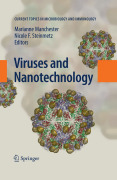
Viral nanoparticles (VNPs) serve as excellent nanobuilding blocks for materials design and fabrication. The main advantages are their nanometer-range size,the propensity to self-assemble into monodisperse nanoparticles of discrete shape and size, the high degree of symmetry and polyvalency, the relative ease of producing large quantities, the exceptional stability and robustness, biocompatibility, and bioavailability. Last but not least, the particles present programmable units, which can be modified by either genetic modification or chemical bioconjugation methods. INDICE: Introduction: Marianne Manchester and Nicole F. Steinmetz.- 1: Chemical modification of viruses and virus-like particles by Erica Strable and M.G. Finn.- 2: Structure-based Engineering of an Icosahedral Virus for Nano-medicine and –technology by Nicole F. Steinmetz, Tianwei Lin, George P. Lomonossoff, and John E. Johnson.- 3: Hybrid Assembly of CPMV Viruses and Surface Characteristics of Different Mutants by Nathaniel G. Portney, Giuseppe Destito, Marianne Manchester, and Mihrimah Ozkan.- 4: A Library of Protein Cage Architectures as Nanomaterials by Michelle L. Flenniken, Masaki Uchida, Lars O. Liepold, Sebyung Kang, Mark J. Young, and Trevor Douglas.- 5: Biomedical nanotechnologyusing virus-based nanoparticles by Giuseppe Destito, Anette Schneemann, and Marianne Manchester.- 6: Tumor targeting using canine parvovirus nanoparticles by Pratik Singh.- Subject index.
- ISBN: 978-3-540-69376-5
- Editorial: Springer
- Encuadernacion: Cartoné
- Páginas: 144
- Fecha Publicación: 01/09/2008
- Nº Volúmenes: 1
- Idioma: Inglés
